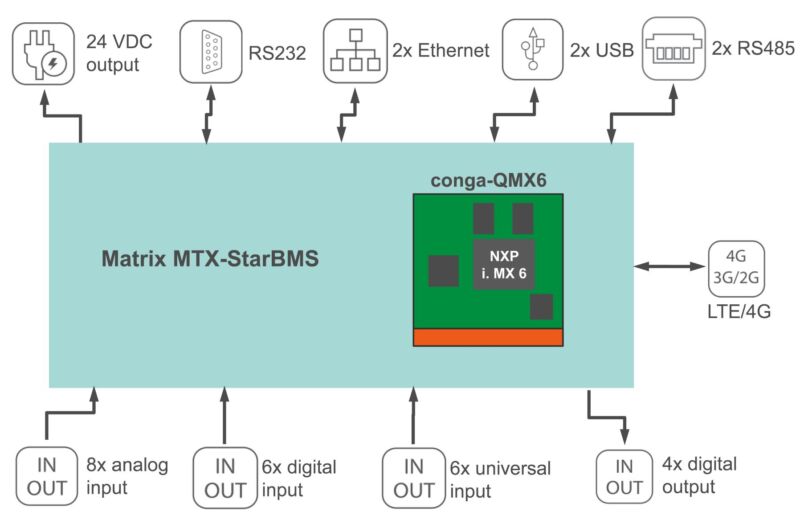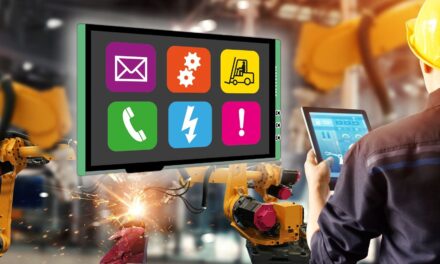A congatec Computer-on-Module (COM) and the Niagara Framework® – that’s the hardware/software duo at the heart of a compact and scalable building automation control centre developed by Spanish electronics company Matrix.
Pleasant indoor climate courtesy of IoT systems
Many large buildings such as hospitals, train stations, offices or residential complexes are equipped with building automation systems today. All too often though, they operate as stand-alone units. IoT-based (Internet of Things) management with higher-level data collection and analysis is rare. Yet the complexity of building management is increasing – beyond standard system monitoring and control, there is now also a need to monitor, network and improve the functionality of the systems to deliver more comfort and sustainable carbon footprint reductions – for instance, by optimizing the blend of self-generated solar energy and external power supply in a networked energy system. IoT-based HVAC (heating, ventilation, and air conditioning) systems find the right balance between heating, ventilation, and humidity to ensure a pleasant indoor climate, regardless of rain or shine or season.
Data analysis at the edge ensures greater security
Wherever networked building automation systems (BAS) are deployed, they increasingly utilize external clouds as control stations and management instances that are networked with the local systems. This makes it possible to configure and control the systems via tablet, smartphone or computer. When it comes to the general management and control of HVAC systems, the route via the cloud is both simple and extremely convenient; everything can be implemented from the cloud and any instance can be granted access to very specific data. No matter where you are in the world. However, there’s more to it than flanging an Ethernet connection to an existing system. In many cases, a new edge layer must be added to perform highly individual local tasks.
Examples are situations where fast decisions are key; this applies especially to safety-critical systems. Cloud-based control stations always experience some latency and may even fail completely if there are network problems. This is why data analysis and BAS-wide decision-making at the edge are increasingly important. Local DIN rail PCs not only process data in real time; they can also instantly initiate protective measures in the event of floods, hailstorms or fires and automatically alert residents or fire services. The summer of 2021, like never before, has shown that extreme weather can endanger human life, besides causing major damage to basements, roofs or building technology within minutes. Early warning systems can use real-time weather data to quickly spot approaching thunderstorms and initiate measures to stormproof the buildings: retract awnings and blinds, close windows and garage doors, switch off power supplies, activate alarms and warn residents.
A DIN rail PC for building automation
Spanish electronics company Matrix packs such software-integrated edge computer solutions for building management into flat DIN rail PCs that fit into any standard control cabinet. In fact, the overall depth is only 64 mm. Headquartered in Madrid and part of the Flexitron Group, the company has made an international name for itself in building automation, among other areas. The latest innovation from Matrix, the MTX-StarBMS (Building Management System), is a compact DIN rail PC that is perfect for BMS control centers. The MTX-StarBMS can communicate with cloud control rooms and other central management instances, and provides a large number of interfaces to allow the connection of any local system. Based on a modular processor architecture, the Matrix solution can be programmed individually.
The embedded computing system, which is based on open standards, combines gateway functions and I/O interfaces and primarily uses the 4G mobile radio standard or Ethernet for cloud communication. It provides six universal, six digital and eight analog inputs, four digital outputs, as well as USB to collect and analyze BAS data directly at the edge. This preconfigured solution simplifies deployment and, thanks to its compact build, is suitable for installation in most fire service control room cabinets or HVAC systems.
MTX-StarBMS comes with a Niagara license
The programmable centerpiece of the MTX-StarBMS is the Niagara Framework® software from US IT company Tridium. Developed specifically for use in building automation, Niagara provides critical, cyber-secure device connectivity towards the cloud and the necessary data normalization capabilities. Besides allowing users to capture and monitor data flows, it also lets them create process chains and custom end user interfaces. This makes it possible to automatically process and visualize measurements and status information from sensors, actuators and systems locally and in real time.
The web-based HTML5 user interface can be displayed on different end devices – even remotely and via the cloud. It can easily be customized by dragging functions from standardized libraries and dropping them into the object-oriented programming environment. In principle, the open and JAVA-based UX (User Experience) framework is suitable for all types of automation tasks as well as monitoring, management and maintenance of building functions. Manufacturers of building technology applications can also use driver modules to integrate their systems into the open platform, which accelerates the development of new applications and networking with existing BMS. As Niagara is fully scalable, the framework can be deployed across different hardware platforms – from large enterprise servers to embedded computing systems.
The processor heart beats in a COM
In terms of the hardware, Matrix has supplemented its own development expertise with established embedded systems: MTX-StarBMS consists of a carrier board developed in-house and a Computer-on-Module (COM) based on the Qsevenstandard, which is maintained and continuously developed by the vendor-independent SGeT (Standardization Group for Embedded Technologies). The module is manufactured by congatec, a leading provider of embedded and edge computing technologies based in Deggendorf, a German Silicon Valley for computer modules. Matrix opted for the Qseven COM because based on an NXP iMX6 processor, it is specifically designed for low-power applications in building management and comes in different variants and configurations. Another important factor was that the modules can be easily upgraded with the latest COMs, such as a Qseven based on the NXP i.MX 8M Plus 14nm processor series offering four-core ARM Cortex-A53 / M7 processors as well as an integrated Neural Processing Unit (NPU) for artificial intelligence, as and when necessary. This not only gives the DIN rail PC great design flexibility; it also guarantees long availability, providing upgrade options for future BMS requirements such as the integration of artificial intelligence (AI).
The first system variant offers up to four ARM Cortex A9 cores, with a power consumption of two to four watts. Support of the extended temperature range of -40°C to 85°C makes it suitable for use in many BMS scenarios worldwide – from the Sahara to the Antarctic. As one of the two highest selling form factors in the world, the Qseven standard has a long-term future. Like the SMARC COM standard, it is hosted by the SGeT on a vendor-independent basis and is a perfect fit for building automation as industrial, municipal or private buildings are generally designed to last for decades.
Well equipped for the future of building automation
Choosing the combo of Niagara Framework and Qseven COM, Matrix has developed the MTX‑StarBMS into a compact DIN rail PC to position itself long term in the cloud-connected BMS market. The rapid pace at which IoT-based sensors, actuators and controls are evolving makes such scalable solutions essential. The COM can be replaced by next generations, and as an open integration platform, the Niagara Framework is future-proof. And future configurations with the NXP i.MX 8M Plus processor with integrated NPU (Neural Processing Unit) make DIN rail PCs conceivable that support AI applications with Deep Learning and Machine Learning. In short, the perfect basis for solutions that leverage predictive maintenance as well as local decision-making based on the Big Data lake that is being fed daily with endless information from every automated building.
By Zeljko Loncaric, Marketing Engineer, congatec



